Research on Directional Controllability of Cracking in Hydraulic Fracturing of Hard Overburden Based on Local Stress Field Intervention
Abstract
:1. Introduction
2. Deformation and Failure Characteristics of the Surrounding Rock in Gob-Side Entry with Small Coal Pillars
2.1. Project Overview
2.2. Theoretical Analysis of Coal Pillar Stability in Roadway Protection under the Condition of Hard Overburden
2.3. Bearing Deformation Characteristics of Coal Pillar in Roadway Protection under the Condition of Hard Overburden
2.3.1. Establishment and Correction of the Model
- (1)
- Model establishment
- (2)
- Model correction
2.3.2. Bearing Deformation Law of Coal Pillar in Roadway Protection under the Influence of Mining
- (1)
- Vertical stress distribution law of coal pillar in roadway protection
- (2)
- Deformation and failure characteristics of coal pillar in roadway protection
3. Research on Pressure Relief Parameters of Hard Overburden Cutting in Gob-Side Entry with Small Coal Pillars
3.1. Simulation Scheme
3.2. Different Top Cutting Positions
3.3. Different Cutting Heights
3.4. Different Top Cutting Angles
4. Research on Directional Controllability of Cracking in Hydraulic Fracturing of Hard Overburden
4.1. Simulation Scheme
4.2. Mechanism of Hydraulic Fracture Propagation in Different Stress Fields
4.3. Propagation Mechanism of Artificial Precast Cracks in Different Stress Fields
5. Industrial Test
5.1. Design of Hydraulic Fracturing Topping Scheme
5.2. Mine Pressure Monitoring
5.2.1. Peeping through the Hole
5.2.2. Surface Displacement
6. Conclusions
- (1)
- The hard roof of the 18506 working face is difficult to collapse, and the hanging roof length is long during mining, which leads to high bearing stress of the coal pillars in the roadway protection, the run-through of the internal plastic zone, and a poor isolation effect, easily leading to harmful gas leakage in the goaf, seriously threatening safe mine production. It is necessary to cut the roof and relieve pressure to ensure that the internal plastic zone of the coal pillar is not penetrated during mining.
- (2)
- Roof cutting and pressure relief can actively cut off the upper roof, change the structure of the hard overburden and broken roof, cut off the stress transmission path, and improve the surrounding rock stress environment of the roof. The top cutting position, top cutting height, and top cutting angle are the key points to realize top cutting pressure relief. The best top cutting position is on the side of the working face, the most reasonable top cutting angle is 0°, and the top cutting height is directly proportional to the top cutting effect.
- (3)
- The propagation mechanism of hydraulic fracture and artificial prefabricated fracture under different stress fields is analyzed. Hydraulic fracture expands perpendicular to the direction of minimum principal stress during high-pressure water injection, and after the artificial prefabricated fracture intersects with the hydraulic fracture, there are three resulting forms of fracture: penetration, unilateral deflection, and bilateral deflection.
- (4)
- The technology of hard overburden roof cutting and pressure relief with an “artificial local stress field realizing directional control of hydraulic fracturing” at its core is proposed, and the industrial test is carried out, reducing the length of the hard overburden roof, releasing the internal stress of the coal pillar in the roadway protection, controlling the deformation, and ensuring the safety of the mining face.
Author Contributions
Funding
Informed Consent Statement
Acknowledgments
Conflicts of Interest
References
- Jia, J.; Cao, L.W.; Zhang, D.J.; Chai, X.W.; Liu, S.Q.; Ma, L.; Han, L. Study on the fracture characteristics of thick-hard limestone roof and its controlling technique. Study Fract. Charact. Thick-Hard Limest. Roof Its Control. Tech. 2017, 76, 605. [Google Scholar] [CrossRef]
- Wang, Q.; Fan, Y.P.; Li, G.; Guo, W.X.; Yan, D.H.; Zhang, L.P. Determination of coal pillar width between roadways of fully mechanised caving face with double roadways layout in a thick coal seam. Rock Soil Mech. 2017, 38, 3009–3016. [Google Scholar]
- He, W.R.; He, F.L.; Zhao, Y.Q. Field and simulation study of the rational coal pillar width in extra-thick coal seams. Energy Sci. Eng. 2020, 8, 627–646. [Google Scholar] [CrossRef]
- Hu, M.L.; Zhao, W.L.; Lu, Z.; Ren, J.X.; Miao, Y.P. Research on the reasonable width of the waterproof coal pillar during the mining of a shallow coal seam located close to a reservoir. Adv. Civ. Eng. 2019, 2019, 3532784. [Google Scholar] [CrossRef]
- Sheorey, P.R.; Das, M.N.; Barat, D.; Prasad, R.K.; Singh, B. Coal pillar strength estimation from failed and stable cases. Int. J. Rock Mech. Min. Sci. Geomech. Abstr. 1987, 24, 347–355. [Google Scholar] [CrossRef]
- Zhang, C.W.; Jin, Z.X.; Song, X.M.; Feng, G.R.; Li, Z.; Gao, R.; Zhu, D.F. Failure mechanism and fracture aperture characteristics of hard thick main roof based on voussoir beam structure in longwall coal mining. Energy Sci. Eng. 2020, 8, 340–352. [Google Scholar] [CrossRef]
- Jiang, L.S.; Wu, Q.S.; Wu, Q.L.; Wang, P.; Xue, Y.C.; Kong, P.; Gong, B. Fracture failure analysis of hard and thick key layer and its dynamic response characteristics. Eng. Fail. Anal. 2019, 98, 118–130. [Google Scholar] [CrossRef]
- Xu, C.; Fu, Q.; Cai, X.Y.; Wang, K.; Zhao, Y.X.; Cai, Y.B. Apparent-depth effects of the dynamic failure of thick hard rock strata on the underlying coal mass during underground mining. Rock Mech. Rock Eng. 2019, 52, 1565–1576. [Google Scholar] [CrossRef]
- Lu, Y.Y.; Gong, T.; Xia, B.W.; Yu, B.; Huang, F. Target stratum determination of surface hydraulic fracturing for far-field hard roof control in underground extra-thick coal extraction: A case study. Rock Mech. Rock Eng. 2019, 52, 2725–2740. [Google Scholar] [CrossRef]
- Yu, Y.; Wang, X.Y.; Bai, J.B.; Zhang, L.Y.; Xia, H.C. Deformation Mechanism and Stability Control of Roadway Surrounding Rock with Compound Roof: Research and Applications. Energies 2020, 13, 1350. [Google Scholar] [CrossRef] [Green Version]
- Wang, T.; You, S.; Pei, F.; Bai, X.P. Instability mechanism and control technology of coal pillar bumps under hard roof. J. Min. Saf. Eng. 2017, 34, 54–59. [Google Scholar]
- Zha, W.H.; Li, X.; Hua, X.Z.; Wu, T.F.; Yin, S.Y. Impact and application on narrow coal pillar for roadway protecting from fracture position of upper roof. J. China Coal Soc. 2014, 39, 332–338. [Google Scholar]
- Du, T.T.; Ju, W.J.; Chen, J.Q.; Zhang, C.J.; Li, H.P.; Sun, R.D. Mechanism of rock burst in fully mechanized caving faces under residual coal seams with hard roof. J. Min. Saf. Eng. 2021, 38, 1144–1151. [Google Scholar]
- Yang, H.Y.; Li, Y.; Liu, Y.B.; Cao, S.G.; Pan, R.K.; Wang, H.; Wang, B.; Chen, X.; Zhao, X.L. Structure evolution and stability control mechanism of hard-roof cutting for roadway retaining. J. Min. Saf. Eng. 2021, 38, 766–773. [Google Scholar]
- Yu, B.; Xia, B.W.; Yu, P. Effect of hard roof breaking on gas emission in fully-mechanized sublevel caving mining of extremely thick coal seam. J. China Coal Soc. 2018, 43, 2243–2249. [Google Scholar]
- Yu, B.; Liu, C.Y.; Yang, J.X.; Liu, J.R. Research on the fracture instability and its control technique of hard and thick roof. J. China Univ. Min. Technol. 2014, 42, 342–348. [Google Scholar]
- Li, L.; Bai, J.B.; Wang, X.Y. Rational position and control technique of roadway driving along next goaf in fully mechanized top coal caving face. J. China Coal Soc. 2012, 37, 1564–1569. [Google Scholar]
- He, M.C.; Ma, X.G.; Wang, J.; Zhang, J.B.; Liu, Y.X. Feature analysis of working face strata pressure with roof cutting pressure releasing in medium-thick seam and compound roof condition. Chin. J. Rock Mech. Eng. 2018, 37, 2425–2434. [Google Scholar]
- He, M.C.; Wang, Y.J.; Yang, J.; Gao, Y.B.; Gao, Q.; Wang, S.B. Zonal characteristics and its influence factors of working face pressure using roof cutting and pressure-relief mining method with no pillar and roadway formed automaticly. J. China Univ. Min. Technol. 2018, 47, 1157–1165. [Google Scholar]
- Guo, J.G.; Li, Y.H.; Shi, S.H.; Jiang, Z.S.; Chen, D.D.; He, F.L.; Xie, S.R. Self-forming roadway of roof cutting and surrounding rock control technology under thick and hard basic roof. J. China Coal Soc. 2021, 46, 2853–2864. [Google Scholar]
- Su, C.; Gong, P.L.; Kang, H.P.; Li, C.; Yi, K.; Liu, C.; Li, P. Mechanism of roof cutting and pressure relief in gob-side and high-stress roadway in deep coal mine. J. Min. Saf. Eng. 2020, 37, 1104–1113. [Google Scholar]
- Wang, F.T.; Tu, S.H.; Yuan, Y.; Feng, Y.F.; Chen, F.; Tu, H.S. Deep-hole pre-split blasting mechanism and its application for controlled roof caving in shallow depth seams. Int. J. Rock Mech. Min. Sci. 2013, 64, 112–121. [Google Scholar] [CrossRef]
- Zhang, B.S.; Wang, P.F.; Cui, S.Q.; Fan, M.Z.; Qiu, Y.M. Mechanism and surrounding rock control of roadway driving along gob in shallow-buried, large mining height and small coal pillars by roof cutting. J. China Coal Soc. 2021, 46, 2254–2267. [Google Scholar]
- Hou, C.J.; Wang, X.Y.; Bai, J.B.; Meng, N.K.; Wu, W.D. Basic theory and technology study of stability control for surrounding rock in deep roadway. J. China Univ. Min. Technol. 2021, 50, 1–12. [Google Scholar]
- He, M.C.; Guo, P.F.; Zhang, X.H.; Wang, J. Directional pre-splitting of roadway roof based on the theory of bilateral cumulative tensile explosion. Explos. Shock Waves 2018, 38, 798–803. [Google Scholar]
- Qin, X.Y.; Zhang, Y.H.; Huang, Z.A.; Gao, Y.K. Breaking mechanism and control technology of hard roof in deep and thin coal seam protective layer. J. Cent. South Univ. Sci. Technol. 2021, 52, 4010–4020. [Google Scholar]
- Gao, Y.B.; Yang, J.; Zhang, X.Y.; Xue, H.J.; He, M.C. Study on surrounding rock control of roadways in deep coal mines based on roof cutting and pressure release technology by directional tensile blasting. Chin. J. Rock Mech. Eng. 2019, 38, 2045–2056. [Google Scholar]
- Zhang, S.L.; Zhang, C.S.; Wang, Y.T.; Wang, C.L. Directional Fracture Blasting in Open-off Cut of Fully-Mechanized Caving Mining Face During Primary Mining. Trans. Beijing Inst. Technol. 2017, 37, 135–140. [Google Scholar]
- Zhao, S.K. A comparative analysis of deep hole roof pre-blasting and directional hydraulic fracture for rockburst control. J. Min. Saf. Eng. 2021, 38, 706–719. [Google Scholar]
- Zhang, F.T.; Wang, X.Y.; Bai, J.B.; Wu, W.D.; Wu, B.W.; Wang, G.H. Fixed-length roof cutting with vertical hydraulic fracture based on the stress shadow effect: A case study. Int. J. Min. Sci. Technol. 2022, 32, 295–308. [Google Scholar] [CrossRef]
- Zhou, X.C.; Ma, X.J.; Liao, X.Y.; Qi, S.W.; Li, H.Y. Numerical simulation of abrasive water jet impacting porous rock based on SPH method. Chin. J. Geotech. Eng. 2022, 44, 731–739. [Google Scholar]
- He, Q.Y.; Zhu, L.; Li, Y.C.; Zhang, B.Y. Simulating Hydraulic Fracture Re-orientation in Heterogeneous Rocks with an Improved Discrete Element Method. Rock Mech. Rock Eng. 2021, 54, 2859–2879. [Google Scholar] [CrossRef]
- Guo, J.C.; Zhao, X.; Zhu, H.Y.; Zhang, X.D.; Pan, R. Numerical simulation of interaction of hydraulic fracture and natural fracture based on the cohesive zone finite element method. J. Nat. Gas Sci. Eng. 2015, 25, 180–188. [Google Scholar] [CrossRef]
- Liu, J.W.; Liu, C.Y.; Li, X.H. Determination of fracture location of double-sided directional fracturing pressure relief for hard roof of large upper goaf-side coal pillars. Energy Explor. Exploit. 2020, 38, 111–136. [Google Scholar] [CrossRef] [Green Version]
- Li, X.W.; Chai, Y.J. Determination of pillar width to improve mining safety in a deep burstprone coal mine. Saf. Sci. 2019, 113, 224–256. [Google Scholar] [CrossRef]
- Zhang, J. Stability of Split-Level Gob-Side Entry in Ultra-Thick Coal Seams: A Case Study at Xiegou Mine. Energies 2019, 12, 628. [Google Scholar] [CrossRef] [Green Version]
- Zhang, Z.Z.; Bai, J.B.; Chen, Y.; Yan, S. An innovative approach for gob-side entry retaining in highly gassy fully-mechanized longwall top-coal caving. Int. J. Rock Mech. Min. Sci. 2015, 80, 1–11. [Google Scholar] [CrossRef]
- Zhang, F.T.; Wang, X.Y.; Bai, J.B.; Wang, G.Y.; Wu, B.W. Post-peak mechanical characteristics of the high-water material for backfilling the gob-side entry retaining: From experiment to field application. Arab. J. Geosci. 2020, 13, 386. [Google Scholar] [CrossRef]
- Huang, B.X.; Zhao, X.L.; Chen, S.L.; Liu, J.W. Theory and technology of controlling hard roof with hydraulic fracturing in underground mining. Chin. J. Rock Mech. Eng. 2017, 36, 2954–2970. [Google Scholar]
- Liu, J.W.; Liu, C.Y.; Yao, Q.L.; Si, G.Y. The position of hydraulic fracturing to initiate vertical fractures in hard hanging roof for stress relief. Int. J. Rock Mech. Min. Sci. 2020, 132, 104328. [Google Scholar] [CrossRef]
- Li, B.B.; Li, J.H.; Yang, K.; Ren, C.H.; Xu, J.; Gao, Z. Evolution law of coal permeability based on comprehensive effect of pore pressure and water. J. China Univ. Min. Technol. 2020, 49, 44–53. [Google Scholar]
- Kang, H.P.; Jiang, P.F.; Huang, B.X.; Guan, X.M.; Wang, Z.G.; Wu, Y.Z.; Gao, F.Q.; Yang, J.W.; Cheng, L.X.; Zheng, Y.F.; et al. Roadway strata control technology by means of bolting-modification-destressing in synergy in 1000 m deep coal mines. J. China Coal Soc. 2020, 45, 845–864. [Google Scholar]
- Chen, S.Y.; Zhao, F.; Wang, H.J.; Yuan, G.X.; Guo, Z.B.; Yang, J. Determination of key parameters of gob-side entry retaining by cutting roof and its application to a deep mine. Rock Soil Mech. 2019, 40, 332–342. [Google Scholar]
- Marek, J.; Andrzej, H.; Mateusz, Ć. Directional Hydraulic Fracturing (DHF) of the Roof, as an Element of Rock Burst Prevention in the Light of Underground Observations and Numerical Modelling. Energies 2021, 14, 562. [Google Scholar]
- Karatela, E.; Taheri, A. Three-dimensional hydro-mechanical model of borehole in fractured rock mass using discrete element method. J. Nat. Gas Sci. Eng. 2018, 53, 263–275. [Google Scholar] [CrossRef]
- Wang, S.; Li, D.Y.; Mitri, H.; Li, H. Numerical simulation of hydraulic fracture deflection influenced by slotted directional boreholes using XFEM with a modified rock fracture energy model. J. Pet. Sci. Eng. 2020, 193, 107375. [Google Scholar] [CrossRef]
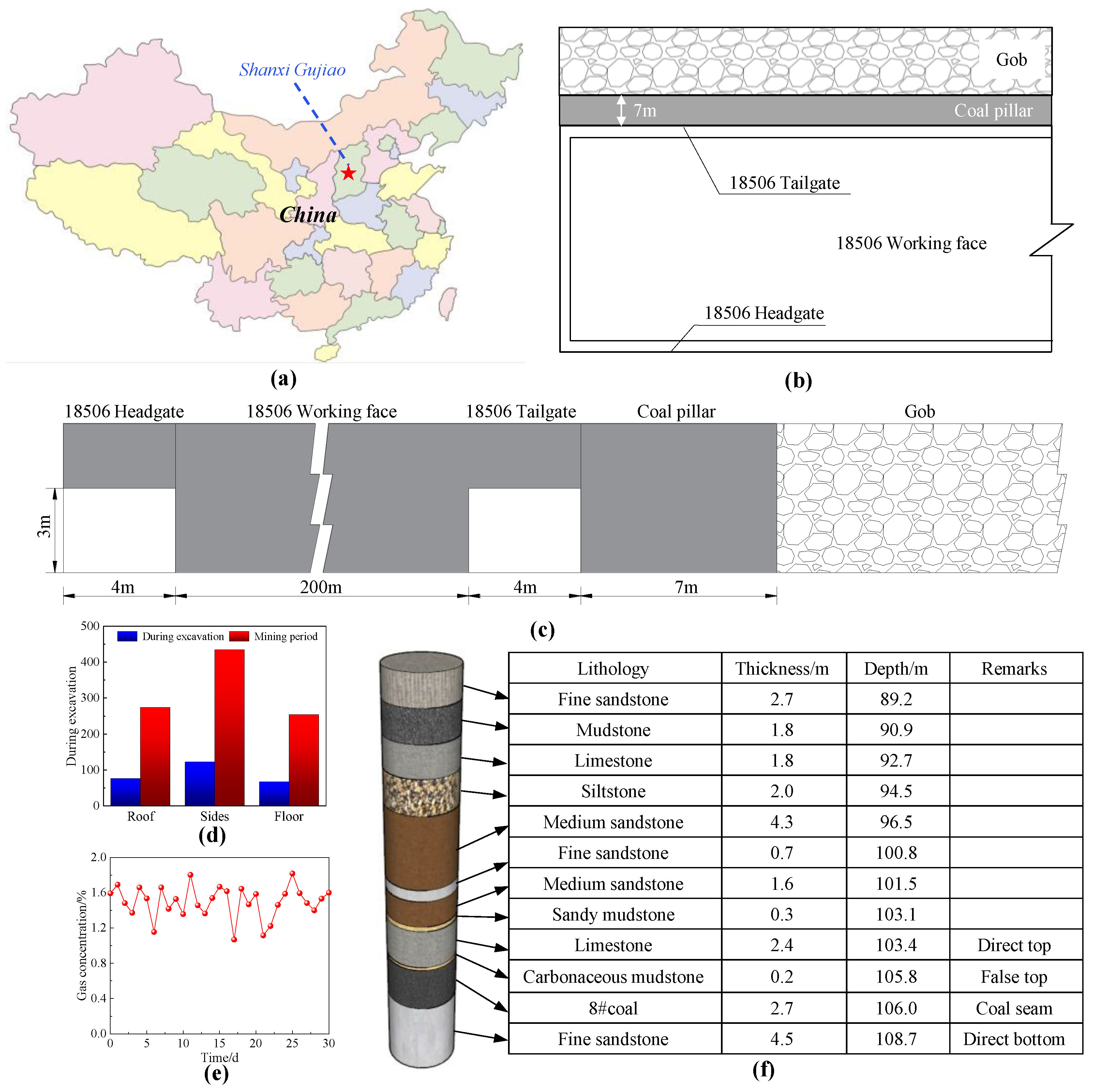
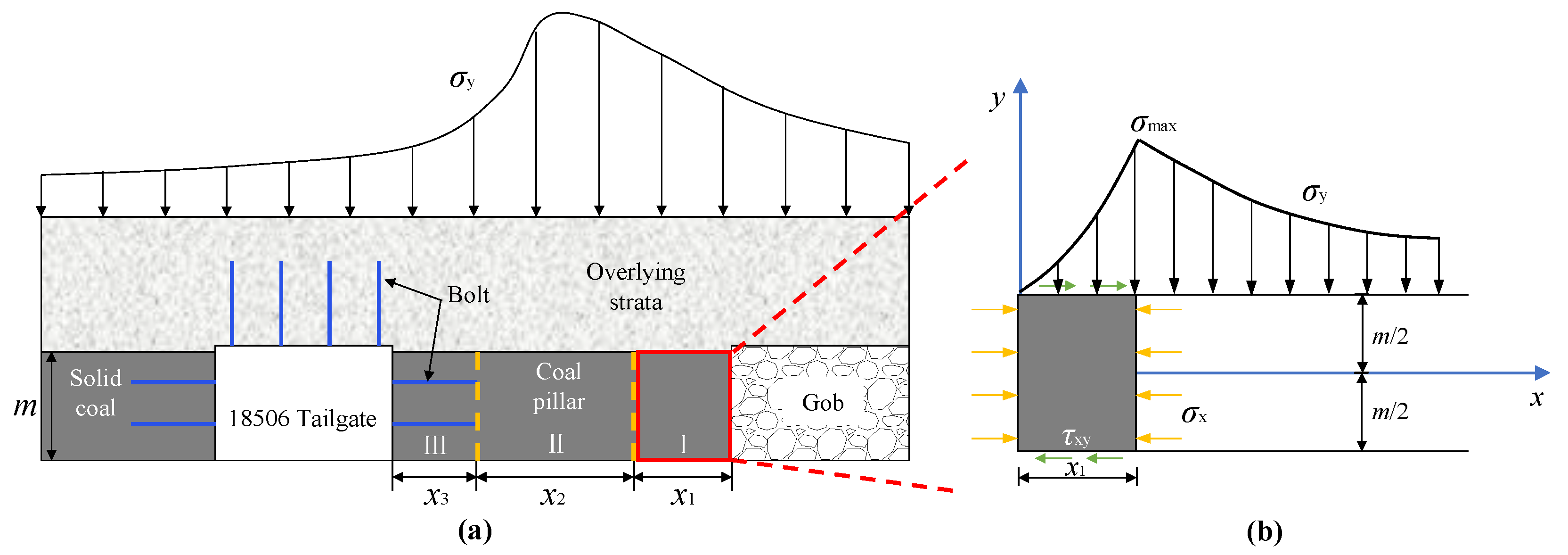

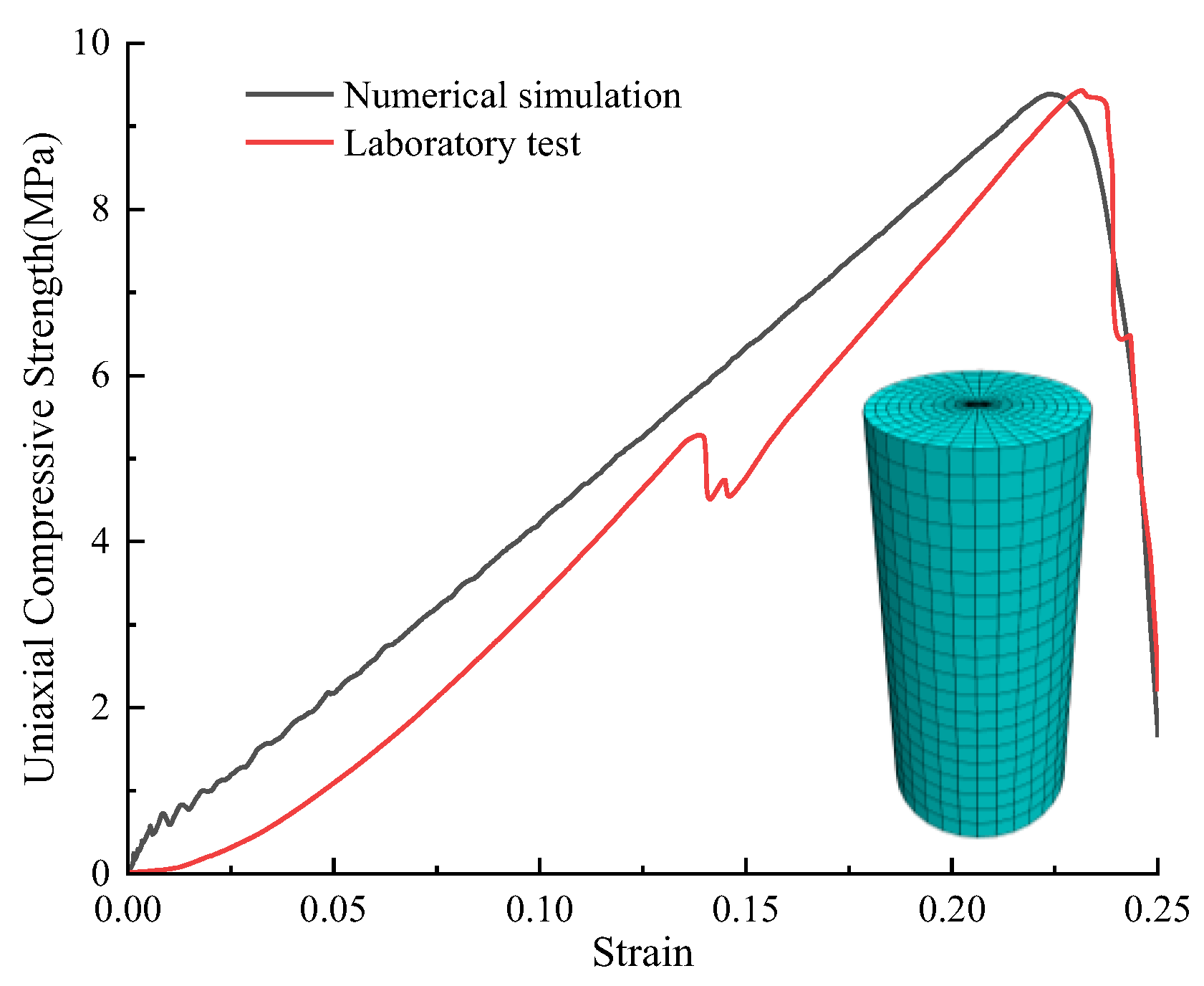
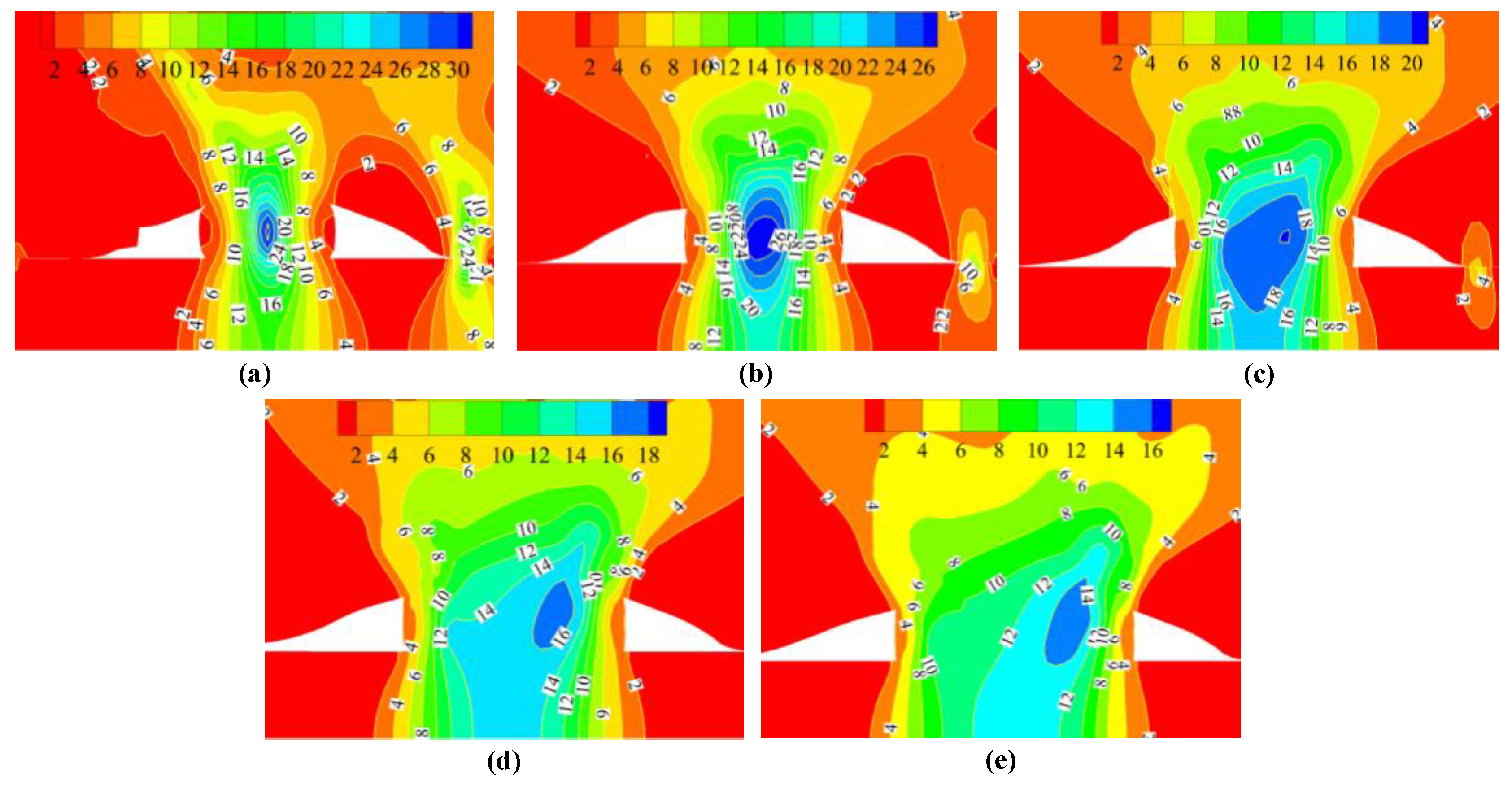
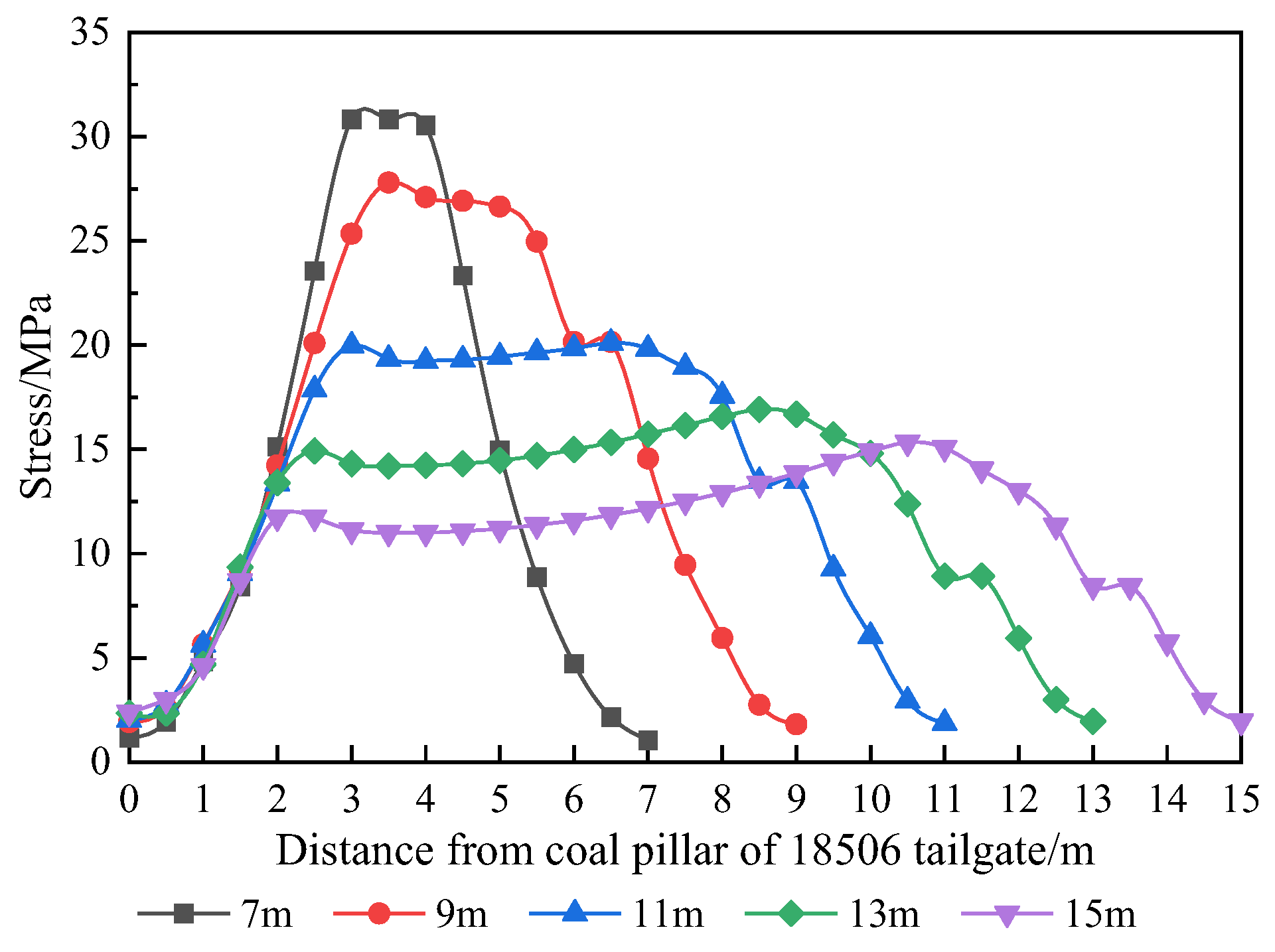







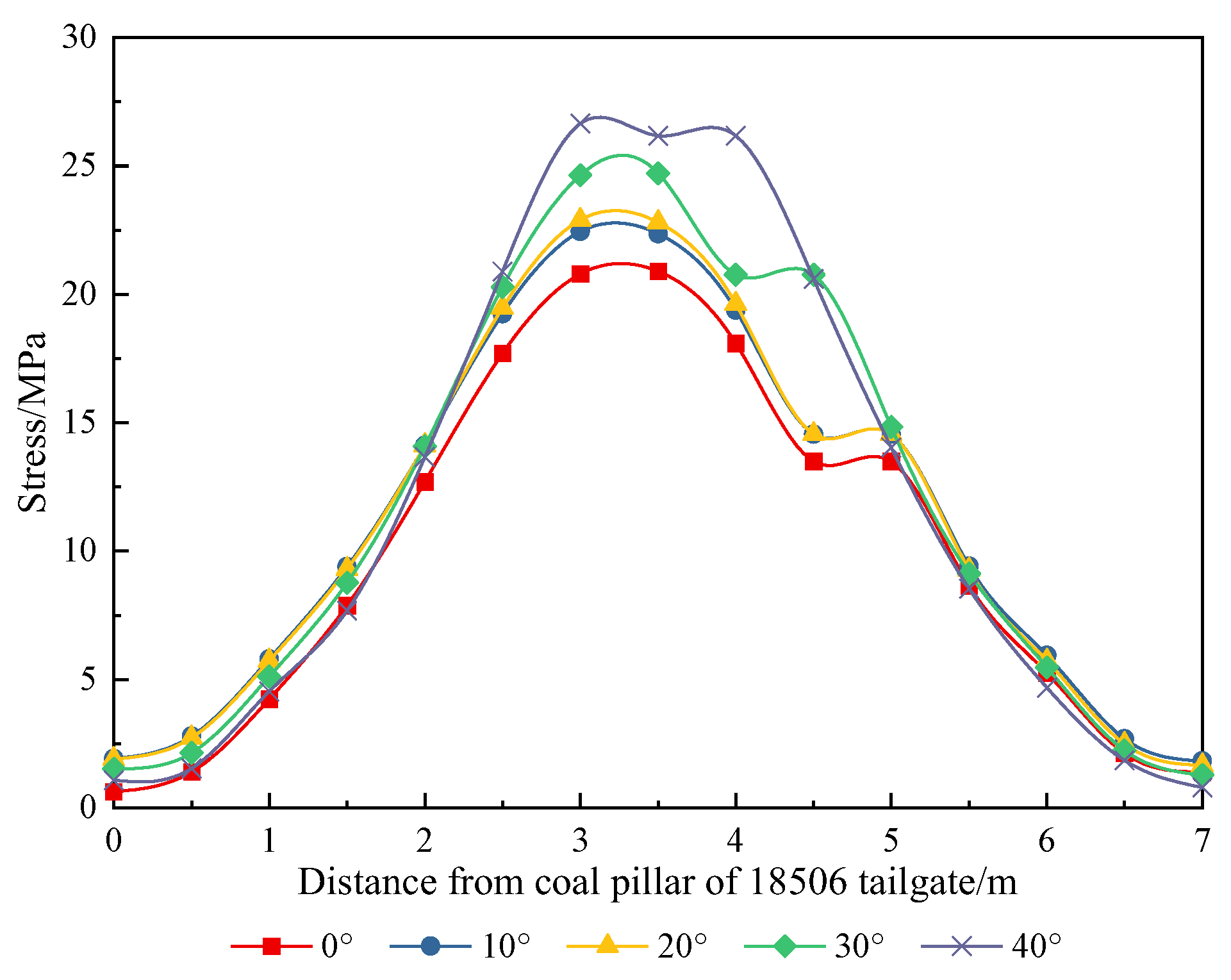
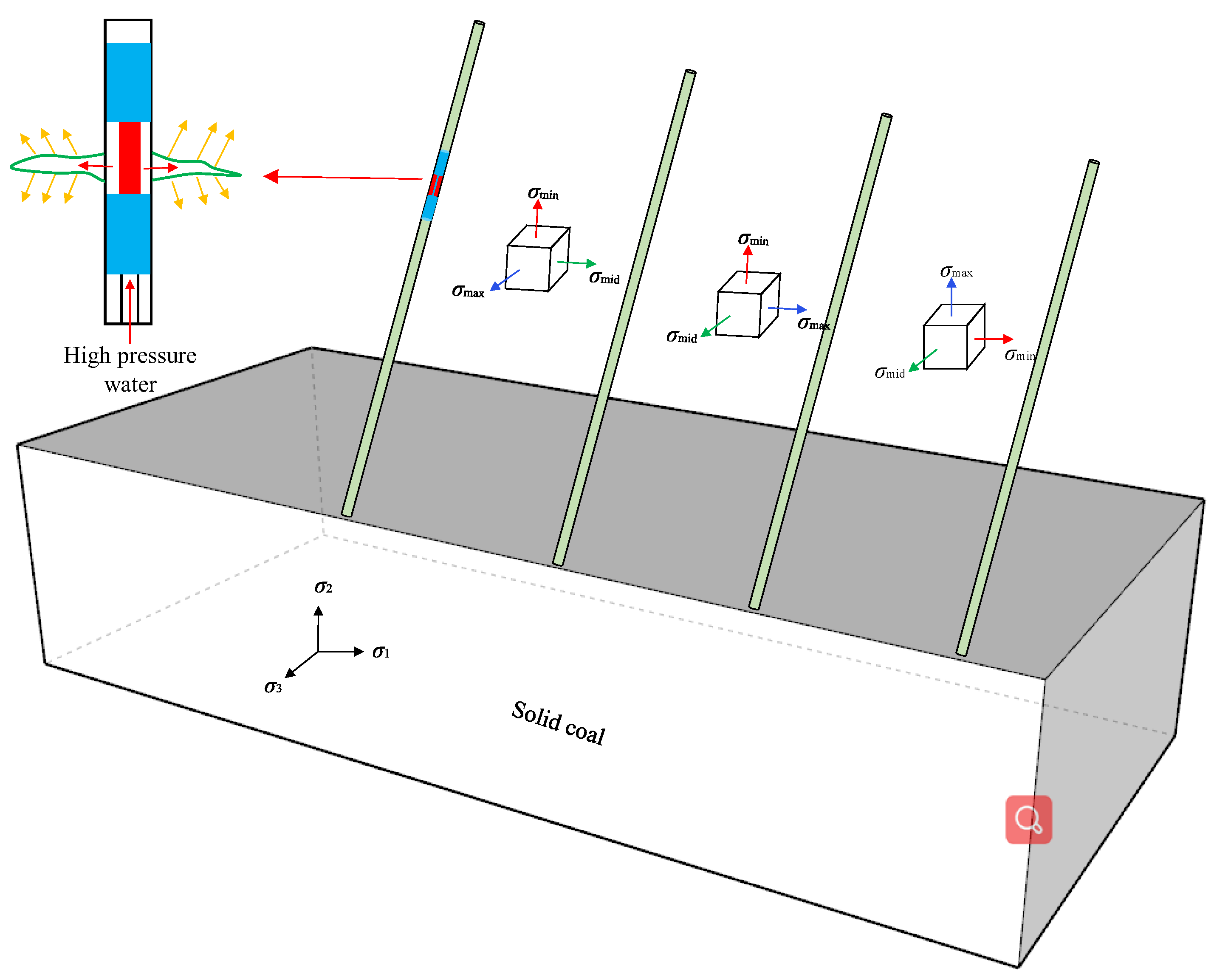






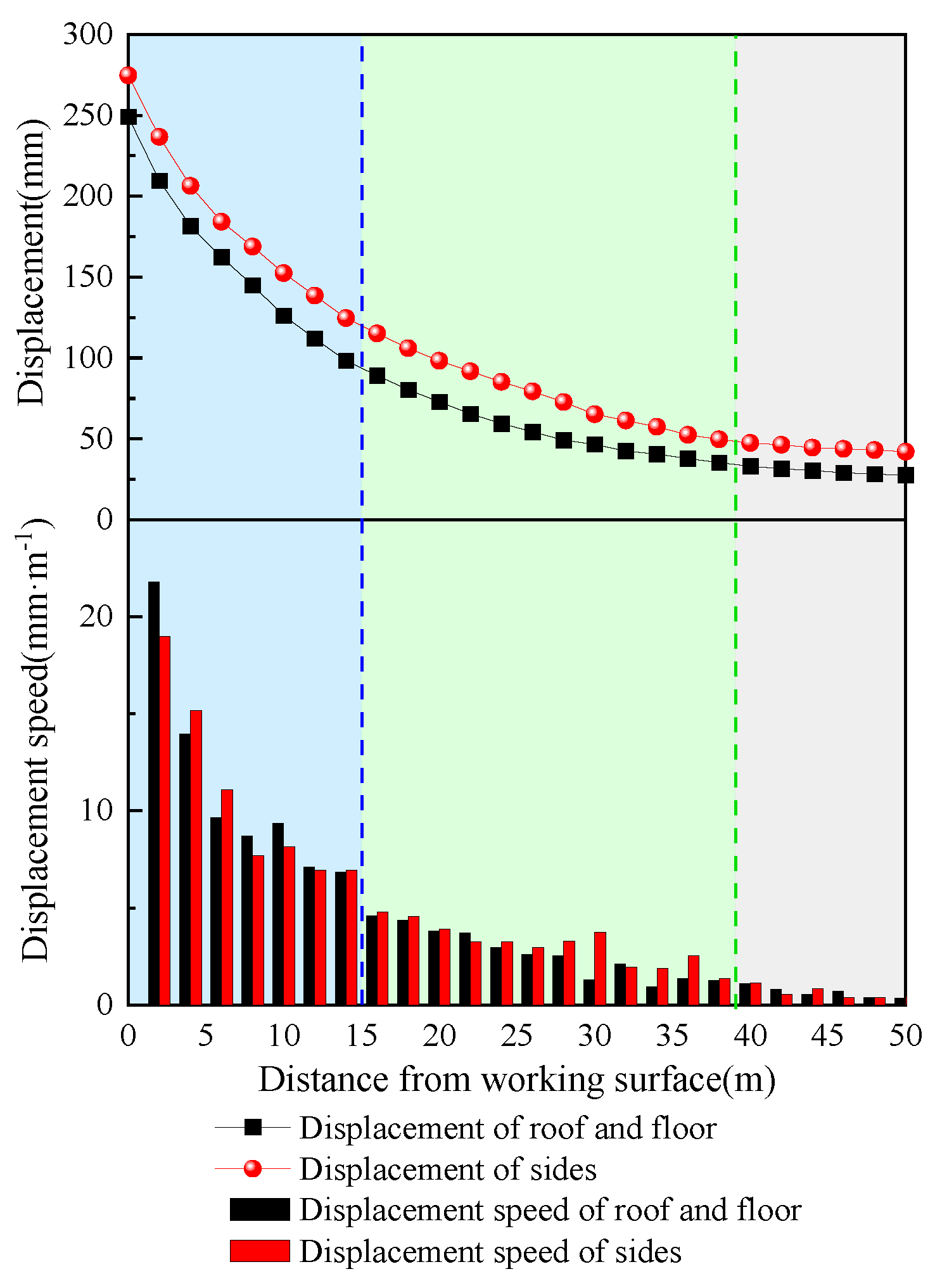
| Lithology | Bulk Modulus (GPa) | Shear Modulus (GPa) | Friction Angle (°) | Cohesion (MPa) | Tensile Strength (MPa) | Poisson Ratio |
|---|---|---|---|---|---|---|
| Fine sandstone | 9.85 | 7.7 | 37 | 7.9 | 5.45 | 0.21 |
| Mudstone | 2.27 | 3.5 | 37 | 3.4 | 0.83 | 0.24 |
| Limestone | 4.76 | 4.8 | 34 | 4.6 | 2.15 | 0.20 |
| Siltstone | 4.83 | 6.7 | 39 | 6.5 | 2.54 | 0.22 |
| Medium sandstone | 10.02 | 8.5 | 36 | 8.1 | 5.77 | 0.25 |
| Sandy mudstone | 2.26 | 4.0 | 35 | 3.5 | 1.05 | 0.20 |
| Carbonaceous mudstone | 2.14 | 3.6 | 35 | 3.2 | 0.97 | 0.23 |
| No. 8 coal | 1.43 | 1.8 | 34 | 3.0 | 0.61 | 0.25 |
| Parameter Type | Numerical Value |
|---|---|
| Elastic modulus/MPa | 10.0 |
| Cohesion/MPa | 8.0 |
| Tensile strength/MPa | 6.0 |
| Poisson ratio | 0.25 |
| Friction angle/° | 36.0 |
| Porosity | 0.1 |
| Specific gravity of fluid/(kN/cm3) | 9800 |
| Permeability coefficient | 1 × 10−7 |
| Fracturing fluid displacement/(m3/s) | 0.01 |
| Fracturing fluid viscosity/Pa·s | 0.01 |
| Type | Drilling Depth/m | Drilling Diameter/mm | Cracking Times | Vertical Elevation | Horizontal Elevation | Distance from the Side/m |
|---|---|---|---|---|---|---|
| P | 26 | 85 | 3 | 45° | 45° | 1.5 |
| Q | 24 | 85 | 3 | 60° | 45° | 1.5 |
Publisher’s Note: MDPI stays neutral with regard to jurisdictional claims in published maps and institutional affiliations. |
© 2022 by the authors. Licensee MDPI, Basel, Switzerland. This article is an open access article distributed under the terms and conditions of the Creative Commons Attribution (CC BY) license (https://creativecommons.org/licenses/by/4.0/).
Share and Cite
Chen, D.; Wang, X.; Zhang, F.; Li, M.; Zhao, X.; Li, G.; Yu, Y.; Wang, G.; Zhao, J.; Wang, X. Research on Directional Controllability of Cracking in Hydraulic Fracturing of Hard Overburden Based on Local Stress Field Intervention. Energies 2022, 15, 4252. https://doi.org/10.3390/en15124252
Chen D, Wang X, Zhang F, Li M, Zhao X, Li G, Yu Y, Wang G, Zhao J, Wang X. Research on Directional Controllability of Cracking in Hydraulic Fracturing of Hard Overburden Based on Local Stress Field Intervention. Energies. 2022; 15(12):4252. https://doi.org/10.3390/en15124252
Chicago/Turabian StyleChen, Dingchao, Xiangyu Wang, Feiteng Zhang, Menglong Li, Xiangqian Zhao, Guanjun Li, Yang Yu, Guanghui Wang, Jiaxin Zhao, and Xiangdong Wang. 2022. "Research on Directional Controllability of Cracking in Hydraulic Fracturing of Hard Overburden Based on Local Stress Field Intervention" Energies 15, no. 12: 4252. https://doi.org/10.3390/en15124252






